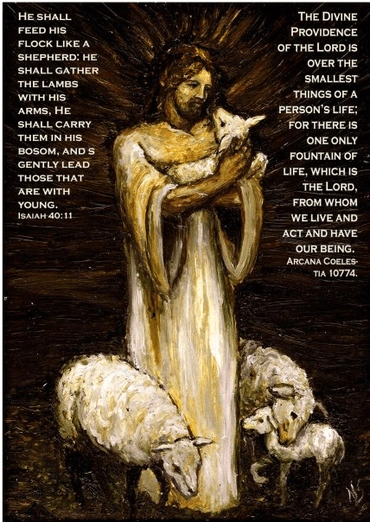Table of Subjects 1
--------------------
1. The Lord's advent.
2. The successive vastation of the church.
3. The church totally devastated, and its rejection.
4. The rejection of the Lord by the church.
5. Temptations of the Lord in general.
6. Temptation even to despair.
7. The combats of the Lord with the hells.
8. Victory over them, or their subjugation.
9. The passion of the cross.
10. The glorification of the Human of the Lord, or its union with the Divine.
11. A new church in place of the former.
12. A new church together with a new heaven.
13. The state of humiliation before the Father.
14. 2
15. A last judgment by the Lord.
16. Celebration and worship of the Lord.
17. Redemption and salvation by the Lord.
--------------------
Editor's Introduction: In this work, Emanuel Swedenborg outlined the internal meaning of all the Prophetical Books, from Isaiah to Malachi, and the Psalms, and then the first 16 chapters of Genesis. It provides a survey of the inner meaning of a substantial portion of the Old Testament, in one place.
This work was written by Swedenborg in Latin, in 1761. It was translated from Latin into English by Rev. J. E. Schreck, and this translation was published by the Swedenborg Foundation, in New York, in 1900. This modified version of Schreck's 1900 translation does not update the text; instead just modifying numbering and formatting for clarity of use online.
Each chapter of each book of the Prophets has one corresponding numbered section in Swedenborg's explanation of its inner meaning, or internal sense. Swedenborg listed the verses that relate to each outlined point. We have added hyperlinks to the verse references, shown to the left of each outlined point. The Psalms and initial chapters of Genesis are treated in a similar fashion.
This work was not published by Swedenborg, but it is consistent with other more detailed treatments made in his published works. For example, Swedenborg refers to this work in Doctrine of the Lord 37.
Readers may also find these comparisons useful:
- No. 124 of this work, explaining Ezekiel 1, with The Doctrine of the New Jerusalem Regarding the Sacred Scripture 97,
- Nos. 161, 162, explaining Ezekiel 38, and 39, with Apocalypse Revealed 859,
- No. 236, explaining Zechariah 4, with Apocalypse Revealed 43, and
- Nos. 244-246 of this work, explaining Zechariah 12, 13, 14, with Apocalypse Revealed 707.
In the manuscript, at the beginning, Swedenborg wrote out a list of works that he intended to write and publish. While it's clearly related to the project of outlining the internal meaning of the Prophets, Psalms, and historical parts of the Word, it seems to be an independent list. We reproduce Rev. Schreck's translation of that list here:
"To Be Published:
1. Concerning the Lord.
2. Concerning the Sacred Scripture or concerning the Word of the Lord.
3. All things of religion and of the worship of God in one complex in the Decalogue.
4. Concerning Faith.
5. Angelic wisdom concerning the Divine Providence.
6. Angelic wisdom concerning the Divine omnipotence and omniscience, and concerning infinity and eternity.
7. Angelic wisdom concerning life.
8. Angelic wisdom concerning the Divine love and Divine wisdom."
Сноски:







